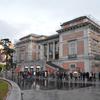More about Eve
- All
- Info
- Shop

Contributor
Eve. You know the name. You know what she did. But you’ve never seen her like this.
This Albrecht Dürer painting is one of two that go together to tell a larger story, one you undoubtedly know. If this is Eve, can you guess who the other one is? Here’s a hint—actually I don’t feel like giving you a hint. It’s Adam, duh.
Albrecht Dürer challenged himself with the task of creating something renaissance-esque, with a German twist. He wasn’t alone in gleaning inspiration from his Italian counterparts. Other northern European artists, like Jan Van Eyck and Hieronymus Bosch, also dabbled in the aesthetic. We see stuff like this today when a popular movie comes out. There are a handful of others trying to capture the magic. It’s interesting so see this same thing play out hundreds of years ago, and with pretty good results, too.
Dürer’s Eve and her counterpart Adam, are special. They are on par with the movement that inspired them, primarily because Dürer was really about that life. Adam & Eve doesn’t give us something we haven’t seen before, per se. That’s not the point. Dürer knows you know the story. In fact, he’s counting on you to know so that you can do some of the work yourself. Take a look at Eve. She stands facing the viewer in front of a black background. We can’t see what’s behind her. The same goes for Adam. This is because Dürer didn’t want to distract you with his interpretation of Eden. Remember, he’s trying to flex that he can paint like a renaissance man. He’s not trying to be bothered by some trees and bushes. He’s delivering on the lifelike depiction of the human body. And he’s using one of the two most well known biblical figures to get your attention.
What makes Dürer’s Eve so interesting is that she isn’t alone in her scene. Adam stands in front of a black background as well, but he’s only accompanied by an apple and a branch to cover his junk. Eve has that Tree of Knowledge which she plucks the apple from to her left, as well as the devilish serpent that influences her. Her contrast to Adam’s painting is subtle, but it could be interpreted that while she doesn’t have a background either, the fact that the snake and the tree are present could suggest her “enlightened” or “awakened” state of mind, while Adam is literally "in the dark," oblivious to anything else around him.
Despite their obvious allure, Adam and Eve were held from the public eye for more than two centuries. After they arrived in Spain in the mid 1600s, they were collecting dust in some back room because they were deemed indecent. The disrespect.
They might be nudes, but at least they’re good ones. Relax a little, Spain. It’s good that the paintings are finally on display after so many years locked away. It’s a little ironic when you think about it. The tale of Adam and Eve is about corruption. And one of the main ways this is conveyed in the story is their change on the stance of their nudity once they eat the apple. And here we are doing the same thing because we’re afraid of what? Somebody seeing a few naked bodies? Looks like we needed to learn the lesson again more than we may have thought.
Sources
- Perez, Sergio. “Albrecht Dürer's Adam and Eve Returns to Public Display at the Prado Museum”. Artdaily. November 24, 2010 https://artdaily.cc/news/42825/Albrecht-D-rer-s-Adam-and-Eve-Returns-to…
- Totally History. “Adam and Eve”. Accessed October 24, 2019 http://totallyhistory.com/adam-and-eve/
- The Art Story. “Summary of Northern European Renaissance”. Accessed October 24, 2019. https://www.theartstory.org/movement/northern-renaissance/
















This work depicts the nude Eve. I think it is a view of mankind before the Fall. At the same time, it reminds me of the yearning for freedom and the liberation of ideas during the Renaissance.